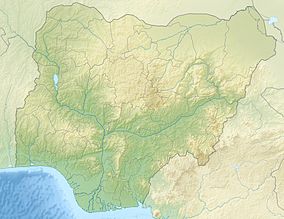Jos Wildlife Park, known as one of the Plateau State's topmost tourist attractions and a place in Nigeria where nature has been conserved. The sights and sounds of nature and wildlife unfold in the park, located in the middle belt of Nigeria along the Jos-Miango road, about 5 kilometres from the city of Jos, and covering an area of 8 square kilometres. It is one of the biggest natural/artificial zoological garden and park in Nigeria.[1]
| Jos Wildlife Park | |
|---|---|
| Location | Nigeria |
| Coordinates | 9°53′7″N 8°50′55″E / 9.88528°N 8.84861°E |
| Governing body | Nigerian Conservation Foundation |
 | |
The park is playing a major part in the development, promotion of tourism and ecotourism in Nigeria.[2]
History
editIn 1972, the Jos wildlife park was established by the governor, Joseph Gomwalk.
The park offers picnic spots in the pine forest and atop Vongnifwel Hill, the highest point east of Jos at 1,345 meters above sea level, which makes it unique for its collection of uncommon and exotic animals. [1]
Wildlife
editThe park is an habitat for various animals, mammals, birds, reptiles included.
- Herbivores: elephants, cattle, elands, gazelles and others can be found at the park
- Carnivores: the park has several lions, crocodiles, hyenas, pythons and other carnivores
- Birds: ostriches, the crowned crane, vultures are among the flight animals the park is proud too have. [1]
In 2020, Mr. Zendi Mukuk an animal lover donated a pregnant African rock python to the park.[3]
References
edit- ^ a b https://www.pressreader.com/nigeria/the-punch/20180902/282741997675145. Retrieved 29 December 2021 – via PressReader.
{{cite web}}: Missing or empty|title=(help) - ^ "How eco tourism can boost economy". The Guardian Nigeria News - Nigeria and World News. 9 March 2016. Retrieved 29 December 2021.
- ^ "Animal lover donates pregnant python to Jos wildlife park". Daily Trust. 6 May 2020. Retrieved 29 December 2021.
